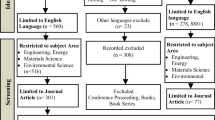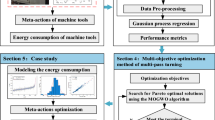Abstract
A machining system is a typical manufacturing system. A green manufacturing function framework of machining systems is structured to describe the traits of input, output and control elements in the system. Based on the function framework, the green manufacturing problem framework of machining systems is presented. The green manufacturing problems in machining systems are classified into three classes and related series of subclass problems. The three classes of problems in the green manufacturing problem framework are the problems of the minimization of resource consumption, the minimization of environmental discharge, and the synthesized minimization of both of them. A series of investigations and practices on green manufacturing in machining system, performed by the authors for quite a long period, are introduced in brief, such as the optimizing system for raw material cutting, the matching system for energy-saving in machining, the design of highly efficient dry hobbing machine tools, the multi-objective decision-making model for green manufacturing in machining systems, and the decision-making supporting system for green manufacturing in machining processes.
Similar content being viewed by others
References
Srinivasan M, Sheng P. Feature-based process planning for environmentally conscious machining—Part 1: microplanning[J]. Robotics and Computer Integrated Manufacturing, 1999, 15: 257–270.
Choi A C K, Kaebernick H, Lai W H. Manufacturing processes modeling for environmental impact assessment [J]. Journal of Materials Processing Technology, 1997, 70: 231–238.
Srinivasan M, Sheng P. Feature based process planning for environmentally conscious machining — Part 2: macroplanning [J]. Robotics and Computer Integrated Manufacturing, 1999, 15: 271–281.
Hur T, Kim I, Yamamoto R. Measurement of green productivity and its improvement [J]. Journal of Cleaner Production, 2004, 12: 673–683.
LIU Fei, CAO Hua-jun, ZHANG Hua. Green Manufacturing Theory and Technologies [M]. Beijing: Science Press, 2005.
YAN Chun-ping, LIU Fei, LIU Ying, et al. Multisoftware collaboration cutting-stock method based on ASP and its implementing technologies [J]. China Mechanical Engineering, 2002, 13(24): 2144–2147.
Kishaway H A, Kannan S, Balazinski M. An energy based analytical force model force model for orthogonal cutting of metal matrix composites [J]. CIRP Asnnals — Manufacturing Technology, 2004, 53: 91–94.
LIU Fei, XU Zong-jun, DAN Bin. Energy Performance of Machining Systems and its Application [M]. Beijing: China Machine Press, 1995.
LI Xian-guang. Study on Design and Assessment Technology of High-Speed Dry-Cutting Gear Hobber for Green Nanufacturing [D]. Chongqing: Chongqing University, 2003.
CAO Hua-jun, LIU Fei, YAN Ping, et al. A decision-making framework model of machining process planning for green manufacturing and its application [J]. International Journal of Environmentally Conscious Design & Manufacturing, 2003, 11(4): 20–27.
YANG Yong, WANG Li-hua, ZHANG Hua. Decisions of machining processes for green manufacturing [A]. YAN Ping. The 10th Annual academic Symposium on Manufacturing Automation Technology Research and Application [C]. Beijing: China Machine Press, 2002; 83–87.
CAO Hua-jun, LIU Fei, HE Yan, et al. Machine tool selection model and its application for green manufacturing[J]. Chinese Journal of Mechanical Engineering, 2004, 40(3): 26–30.
TAN X C, LIU F, CAO H J, et al. A decision-making framework model of cutting fluid selection for green manufacturing and a case study[J]. Journal of Materials Processing Technology, 2002, 129: 467–470.
TAN Xian-chun, LIU Fei, CAO Hua-jun, et al. A decision-making framework model of tool selection for green manufacturing and its applications[J]. Journal of Chongqing University (National Science Edition), 2003, 26(3): 117–121.
TAN Xian-chun, LIU Fei, CAO Hua-jun, et al. Decision-making model for process route in green manufacturing and its algorithms [J]. Chinese Journal of Mechanical Engineering, 2004, 40 (4): 154–159.
CAO Hua-jun. Study on Process Planning Technologies for Green Manufacturing [D]. Chongqing: Chongqing University, 2004.
Author information
Authors and Affiliations
Corresponding author
Additional information
Foundation item: Project (50475062) supported by the National Natural Science Foundation of China; project (47-19) supported by the Natural Science Foundation of Chongqing, China
Rights and permissions
About this article
Cite this article
Liu, F., Yin, Jx., Cao, Hj. et al. Investigations and practices on green manufacturing in machining systems. J Cent. South Univ. Technol. 12, 18–24 (2005). https://doi.org/10.1007/s11771-005-0004-2
Received:
Accepted:
Issue Date:
DOI: https://doi.org/10.1007/s11771-005-0004-2




